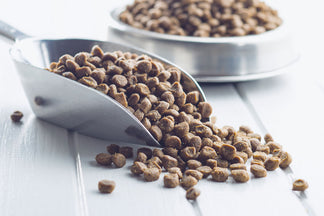The three macronutrients (besides water) that make up the majority of a pet food are protein, fat, and carbohydrates. A pet owner who reads their pet’s food label will notice that protein and fat percentages are reported but there is often no reference at all to the carbohydrates. This is not an act of subterfuge as pet food manufacturers are required to report protein and fat content, but are not required to report on the carbohydrate content. Have you ever wondered why this is the case?
Why aren’t Carbohydrates Listed on the Pet Food Label? Protein and fat are required macronutrients for dogs and cats. AAFCO has established minimum values for pet foods to be considered complete and balanced diets. Carbohydrates, on the other hand, are not an essential for dogs and cats and thus, there are no labeling requirements, let alone minimum or maximum standards that pet food companies need to adhere to. Said again, there is no known carbohydrate requirement for dogs and cats—they are carnivores after all and thrive on high protein and fat diets. Yet, the average commercially available dog food is laden with carbohydrates, over 47% for dry foods and 34% for wet foods, while the average dry cat food and wet food contains 37% and 28% respectively.
Why are Carbohydrates Included in Dog Food? Carbohydrates are used in abundance in most pet foods for many reasons, but primarily they are included because they are a low cost source of energy and can help to keep the price of pet food more affordable. Carbs are not inherently bad, but they should make up 1/3 or less of the daily calories for most normally healthy dogs and even less for cats.
Carbohydrates can provide some benefits as a macro-nutrient including:
Provide Energy. Although dogs and cats are able to convert protein and fat to satisfy their energy requirements, carbohydrates are a cheaper way to provide adequate energy for your pet.
Provide Beneficial Fiber. Carbohydrates are the source of dietary fiber, which promotes overall gastrointestinal health by increasing gastrointestinal motility and by collecting debris and dead cells that accumulate in the gastrointestinal tract. Soluble fibers, sometimes called prebiotics, aid in promoting the growth of additional beneficial (or probiotic) bacteria and helps crowd out pathogenic (disease-producing) bacteria.
Creates Satiation. Carbohydrates (and their associated fiber) helps the pet feel satiated and thus, ‘less hungry’.
Like with protein and fats, not all carbohydrates are created equal. Finding a low carb food is a great first step, but making sure that the source of carbohydrates is high quality is equally important. When it comes to carbs, choose those that are less processed vs more processed. Processing can remove dietary fiber, iron, and some vitamins, so refined carbs provide less nutrition but still contain the same number of calories.
Some examples of higher quality carb sources include sweat potato, sorghum, most fruits and vegetables.
Carb sources to avoid include white rice, wheat, wheat flour, gluten, and corn.
Starchy vegetables, like peas and plain potatoes are commonly found in pet foods. These ingredients aren’t bad per se, but often they are used as substitutes for animal proteins so be wary of foods that contain these high in the list of ingredients or that contain multiple forms of these (e.g. peas and pea protein) in their ingredient list.

 Food
Food
 Food
Food
 Food
Food
